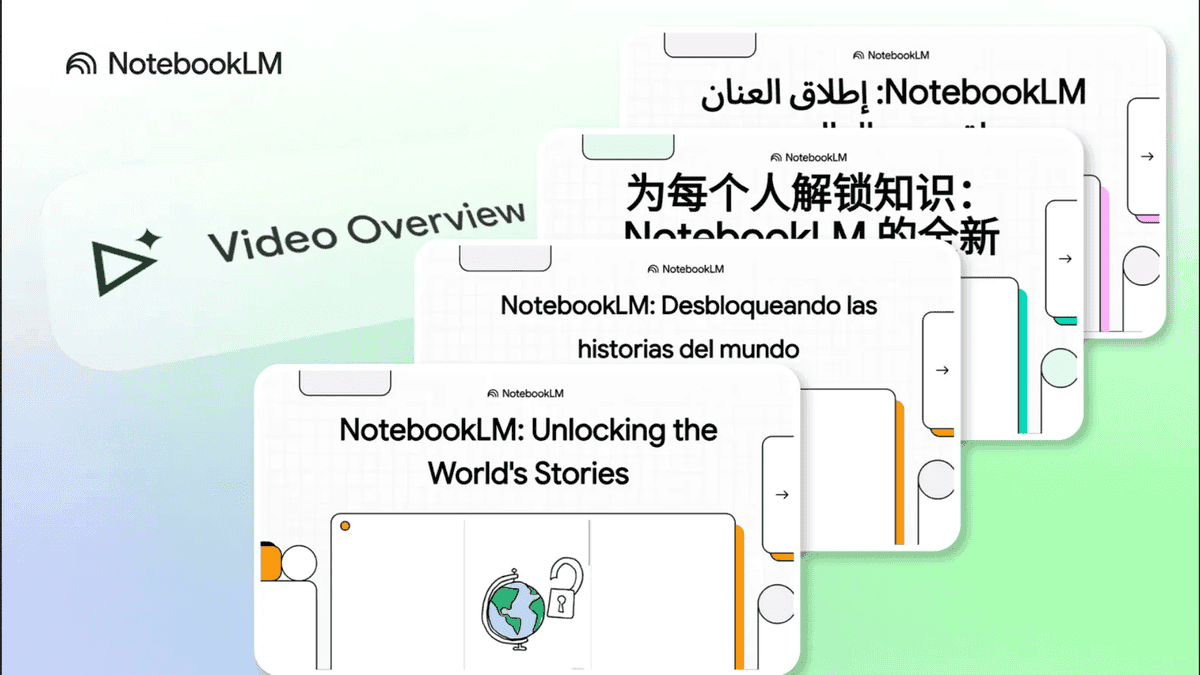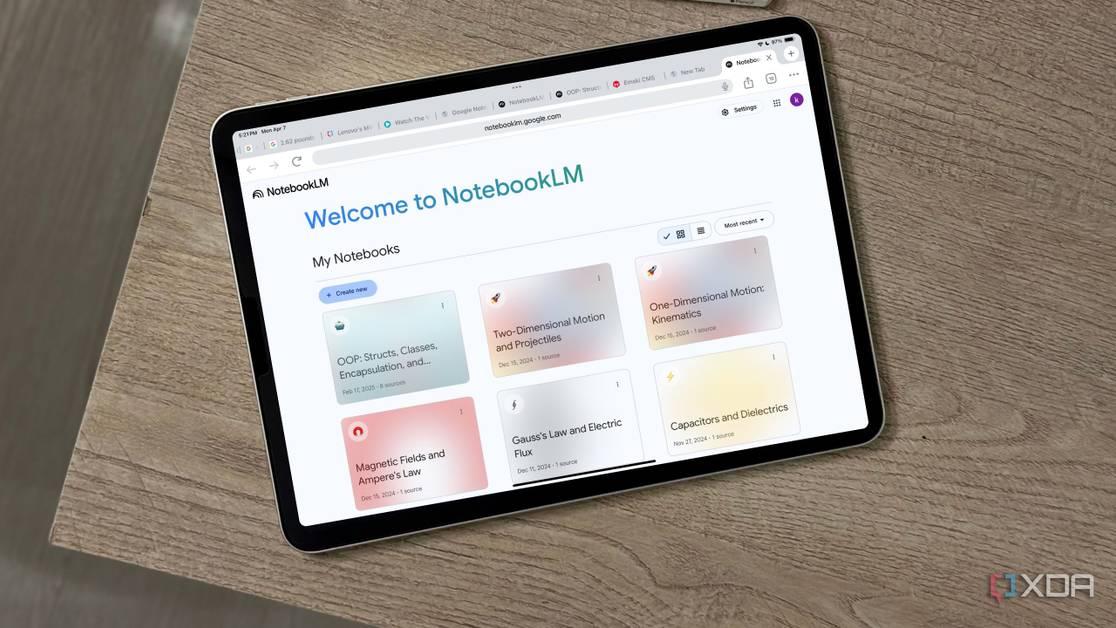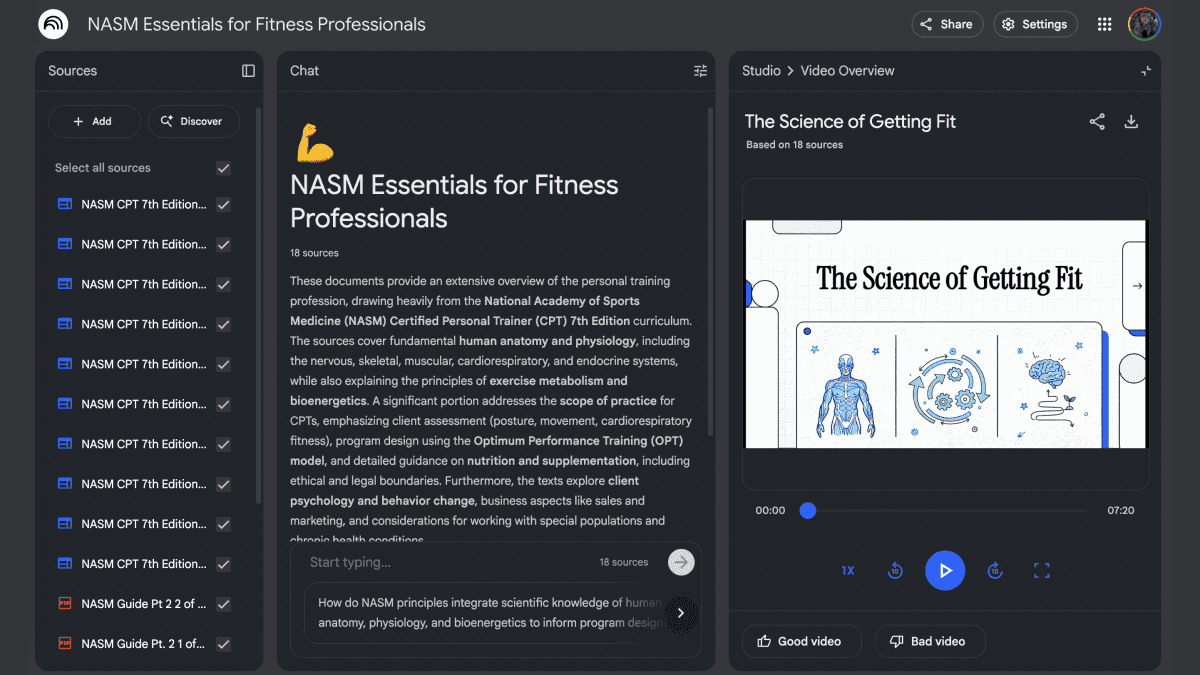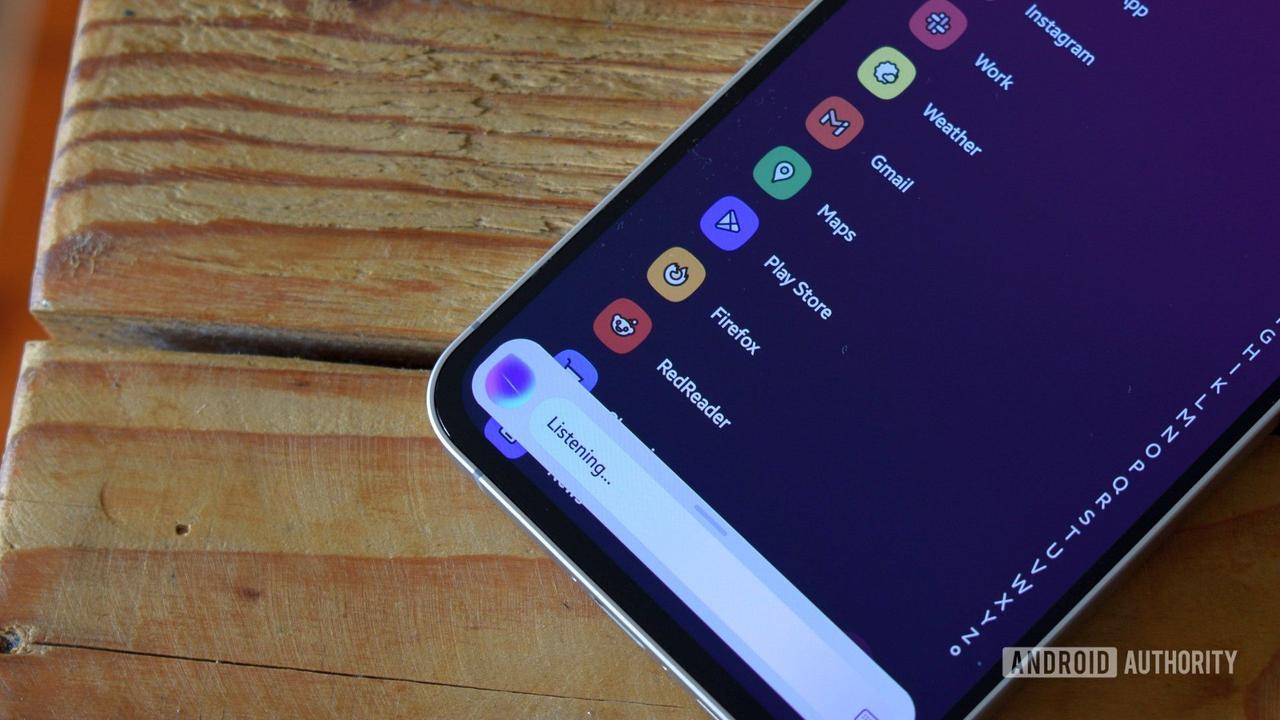Google's NotebookLM Expands AI Capabilities to Summarize YouTube Videos and Audio Files
8 Sources
8 Sources
[1]
Google NotebookLM Now Summarizes YouTube Videos and Audio Files
The tool, launched initially at Google's I/O developer conference last year and now available in over 200 countries, including the US, India, and the UK, enhances its versatility. Initially designed for educators and learners, NotebookLM has seen a considerable shift in its user base, now attracting many professionals from various business sectors. This shift prompted Google to introduce features that cater to a broader demographic, encouraging more interactive and collaborative work environments. Raiza Martin, a senior product manager for AI at Google Labs, highlighted that the tool's user base is now evenly split between educational and professional users. The recent addition, Audio Overview, allows users to transform their documents into engaging audio discussions. This feature is further enhanced by the ability to share these audios via a public URL. It aims to facilitate better communication and sharing among users, making it easier for professionals to disseminate information like presentations and resumes in a more dynamic format.
[2]
Google's NotebookLM can now transform YouTube videos into study guides - here's how
Google's NotebookLM, an artificial intelligence (AI)-powered notebook, is expanding its source base. Today, you can now add public YouTube URLs and audio files directly into your notebook. These additions let users summarize lectures, compare the contents of audio files, and transform video and .mp3/.wav audio into study guides. As Google said in the release, NotebookLM is "part note taker, part collaborator, part data collector, and part librarian," letting users craft a digital notebook composing all the research, documents, and other source material they collect. Also: Google's NotebookLM can discuss your notes with you now. How to access it Last week, NotebookLM launched an Audio Overview feature that allows users to discuss their notebook content conversationally with AI. This lets users access all the information they need to tackle a paper, develop a presentation, or better grasp complex topics. Google also announced that, as of today, users can now share the audio notes created from the Audio Overview feature via public link. When you're finished with a note, just tap Share, and NotebookLM generates a URL that you can share with others. This new sharing option allows users to build dialogue with a bigger network. However, Google NotebookLM is still in the experimental phases. Google has previously warned that the Audio Overview feature has its limitations, such as taking several minutes to generate an Audio Overview for larger notebooks and containing inaccuracies. Also, users can't interrupt the hosts mid-dialogue. Also: 98% of small firms are using AI tools to 'punch above their weight' Another limitation is that conversations are only supported in English, excluding large groups of people from accessing the tool entirely. Follow these steps to tap into NotebookLM's new features: Visit the NotebookLM website or Google Labs and click Try NotebookLM. You'll need a Google account to sign in and create a new notebook or access an existing one. Also: Meta takes some big AI swings at Meta Connect 2024 Try using a public URL, such as a YouTube link or an audio file, to generate an Audio Overview. Once the Audio Overview is ready, tap Share.
[3]
NotebookLM Now Lets You Transform YouTube Videos Into Quick Notes; Here's How
The tool also gives you Suggested questions to ask in related to the summarization, or ask your own questions. Google's AI NotebookLM is already everything that a student ever needed it to be. From breaking down content into easy-to-understand summarization to citing sources easily, it's a power-packed tool that makes me wish I had back in my school days. Now, the tool just gotten even better, for Google has given it the power to analyze and break down YouTube videos. The new functionality has been added to the tool as a new source type, which lets you copy and paste YouTube videos to begin the process. Our in-house AI expert, Arjun Sha, has already done a detailed hands-on on how to use NotebookLM, which you can check out. So, I won't get into immense details here. However, I'll certainly take you through how the new functionality looks and works: This way, you can easily transcribe and summarize lengthy YouTube videos and save a whole lot of time. However, that's not just it. The true power of NotebookLM lies in being able to further answer any additional queries you have. For example, after a summarization, the Suggested questions panel will list some pretty impressive questions to ask the AI tool relating to the content. To make things more fun, well, you can also generate a full-fledged podcast out of your sources, thanks to the Audio Overview feature. You can make use of these to further understand topics that are difficult to grasp. Additionally, you can take to the chat and ask questions of your own and see the tool decode all of that for you. This is beyond helpful and can help students cover topics way faster than any other conventional studying methods or tools if you ask me. However, it's not just students who will benefit from it. Under the Help me create panel, you will see a bunch of templates that let you transform the YouTube video into a Study Guide, Briefing Doc, Timeline, and more with just one click. In addition to the YouTube video breakdown, Google has also added the functionality of sharing Audio Overviews. So, all-in-all, this is a pretty meaningful addition to the tool, and I'm all for it. What do you think about it though? Drop your thoughts in the comments down below!
[4]
Google's NotebookLM enhances AI note-taking with YouTube, audio file sources, sharable audio discussions | TechCrunch
Google on Thursday announced new updates to its AI note-taking and research assistant, NotebookLM, allowing users to get summaries of YouTube videos and audio files and even create sharable AI-generated audio discussions, as the search giant aims to broaden the use cases and reach of the tool, which was originally launched as a project at its I/O developer conference last year and expanded to markets including India, U.K., and over 200 countries months after its debut for public access in the U.S. NotebookLM, which was initially used by educators and learners, has more recently seen a significant shift in its user base and is now attracting more people in a workplace environment. Raiza Martin, a senior product manager for AI at Google Labs, said in an exclusive interview that the tool's users are now roughly split, with 50% being educators and learners, and the other half consisting of business professionals. "People are now sharing notebooks, and it's creating a network effect," she told TechCrunch. This gave the NotebookLM team a push to introduce new features, with the hopes of enhancing its network effect and making the tool popular among people of different demographics. Earlier this month, NotebookLM added Audio Overview to let users turn their documents into engaging audio discussions. The latest update expands that experience by allowing users to share the Audio Overview generated in NotebookLM with a public URL. To use the feature, you click on the share icon available on the Audio Overview generated in the tool to get its URL, which you can then copy and share with others. Martin said that her team saw professionals uploading webpages, resumes, and even their presentations on NotebookLM to generate Audio Overviews, then sharing those with their employers, colleagues, or clients. NotebookLM also added support for YouTube videos and audio files (such as .mp3 and .wav) as new source types, alongside its existing support for Google Docs, PDFs, text files, Google Slides, and webpages. The new features help users summarize key points from YouTube videos and generate takeaways and insights from the audio recordings they have of their study sessions or projects. Martin told TechCrunch that since Google Labs has a small team working for NotebookLM, powered by the company's multimodal large language model Gemini 1.5 Pro, every new feature the team adds to the tool is based on user feedback. "What's interesting about AI tools is that a lot of assumptions change," she said. "What might have been useful last year might not be useful this year." In June, Google expanded NotebookLM access to over 200 countries after launching it initially in the U.S. late last year. Martin told TechCrunch, without disclosing specific numbers, that while NotebookLM still has a majority of its usage in the U.S., Japan has emerged as the next big market for the tool. The executive also underlined that some of its users are using NotebookLM to get AI-based summarization in languages different from what they set on the tool. "In Japan particularly, we see a lot of documents that are not in Japanese, but NotebookLM is set to Japanese," she said. "So people are querying in their native language, using it with probably complex and dense documents in English." Google said that the information users upload to NotebookLM stays private and is not used to train an AI model. To access the tool, users have to be at least 18 years old. Still, NotebookLM faces challenges inherent to its nature as an AI tool. One is that if users rely too much on NotebookLM, they might quickly lose the habit of reading long-form content and research papers. This could also lead to the problem of oversimplification. Martin told TechCrunch that her team is very well aware of these concerns. NotebookLM provides clickable citations from the content users upload to let users go deeper into the summarized notes. "We try to encourage you to read your original text. We encourage you to double-check all the answers that come out of NotebookLM... You could read SparkNotes or the actual book; it's always up to you," she said. NotebookLM is currently limited to the web, though Martin indicated that its mobile apps may come sometime next year. Meanwhile, the team is busy adding more new features. These will be focused on adding more support on the input side and new sources for outputs, Martin said.
[5]
Google's NotebookLM can help you dive deeper into YouTube videos
If you buy something from a Verge link, Vox Media may earn a commission. See our ethics statement. NotebookLM, Google's AI note-taking app, can now summarize -- and help you dig deeper into -- YouTube videos. The new capability works by analyzing the text in a YouTube video's transcript, including auto-generated ones. Once you add a YouTube link to NotebookLM, it will use AI to provide a brief summary with key topics discussed in the transcript. You can then click on these topics to get more detailed information as well as ask questions. (If you're struggling to come up with something to ask, NotebookLM will suggest some questions). When I dropped in The Verge's iPhone 16 Pro review, NotebookLM generated topics discussed in the video like "Apple Intelligence," "iPhone 16 Pro Camera," and "Photo processing" in its chat window. After clicking on some of the topics, I found that NotebookLM backs up the information provided in its chat window with a citation that links you directly to the point in the transcript where it's mentioned. You can also create an Audio Overview based on the content, which is a podcast-style discussion hosted by AI. I found that the feature worked on most videos that I tried, except for ones published within the past two days or so. While Google's Gemini and Microsoft's Copilot can both summarize YouTube videos with transcripts, NotebookLM gives you some jumping-off points you can use to learn more about a topic. In addition to adding support for YouTube videos, Google announced that NotebookLM now supports audio recordings as well, allowing you to search transcribed conversations for certain information and create study guides.
[6]
NotebookLM can now summarize YouTube videos
You can now upload YouTube videos and audio files to NotebookLM, an AI-powered summarizing tool for education and research. The update means Google's Gemini 1.5 Pro-powered virtual assistant can now handle Google Docs, PDFs, text files, Google Slides, YouTube video URLs, audio files and web pages. This expands NotebookLM's potential sources to include lecture recordings, informative YouTube content and group discussions. Google claims that it securely stores all information uploaded to NoteBookLM and does not use it to train AI. Google launched the virtual research assistant in the summer of 2023 and upgraded it to run on Gemini 1.5 Pro this past June. Alongside the AI-powered bump, Google expanded NotebookLM to be available in over 200 countries and territories. Most recently, Google added Audio Overview to NotebookLM. The tool has two AI hosts -- hopefully not foreshadowing what hosting will look like in the future -- discuss your sources, summarize material and "banter." Google is now adding the ability to share Audio Overviews with others through a public URL. The irony here is that the reason we'd need an AI to briefly summarize a YouTube video in the first place is because Google incentivized the creation of ever-longer videos.
[7]
Google Labs adds video and audio input to AI-powered note-taking assistant NotebookLM - SiliconANGLE
Google Labs adds video and audio input to AI-powered note-taking assistant NotebookLM Google LLC today rolled out new features for its artificial intelligence note-taking and research assistant NotebookLM, including the ability to upload videos from YouTube URLs and audio files directly, in addition to text, PDFs, Google Docs and web pages. NotebookLM is an experimental tool from Google Labs that uses the company's powerful Gemini 1.5 large language model's multimodal capabilities to enhance note-taking, organize ideas and extract insights from source materials. It allows users to upload multiple sources including numerous documents, now including audio and video. Sources are limited to 500,000 words. Currently, NotebookLM is limited to a maximum of 50 sources and 1,000 notes per notebook. Over the summer, the company expanded access to NotebookLM globally, and the new options will open up its capabilities for even more note-taking opportunities such as the analysis of video essays and lectures. It would also make group projects and discussions more productive by allowing it to listen to audio recordings from group study sessions or team meetings. NotebookLM automatically generates a summary and source guide when documents are uploaded, including key topics and suggested questions designed to help users make deeper dives into the subject material. This allows users to interact with the sources more easily and provides passage highlights and citations that lead directly to the source material that generated responses. The application produces two types of notes: saved model-generated responses from chat interactions or direct quotes, and user-composed written notes. The saved responses can be cited directly from the source material that generated them so that users can quickly locate their context. NotebookLM also has additional functions for generating study guides, short answer quizzes, essay questions, frequently asked questions and glossaries. Earlier this month, Google introduced Audio Overview to the application, which allows users to turn their notes into an engaging audio discussion between two English speakers. The speakers, voiced by AI, discuss the subject like a pair of podcast hosts who go over the source material in depth. They summarize the material, make connections between topics and make friendly banter back and forth as they go. The Audio Overview capability is still experimental and has some known limitations. For large notebooks, it may take several minutes to produce, but users need only click the generate button and walk away until they're done. Overviews are currently only available in English and can sometimes introduce inaccuracies. With today's feature update, Google added an option to share Overviews with a URL. Users can now click on a share icon on the Audio Overview generated in NotebookLM and it will produce a public URL that can be shared on the web, social media or text message - even with users who do not have a NotebookLM account.
[8]
NotebookLM can now use uploaded audio and YouTube videos as sources
Earlier this month, Google launched Audio Overviews in NotebookLM that turn your notes into a podcast. The latest NotebookLM update lets you use audio files and YouTube videos as sources. At the moment, you can upload PDF, .txt, and Markdown files to NotebookLM, as well as directly paste text. Webpages, Google Docs, and Google Slides can also be used as one of your 50 sources. NotebookLM will now let you upload audio files (like .mp3s or .wavs) and videos on YouTube. (Gemini does not let you upload audio or video yet.) Example use cases in NotebookLM include: Meanwhile, you can now share Audio Overviews as links. This feature, which generates a back-and-forth discussion with AI hosts, has been quite popular for presenting summaries and connections in a natural manner that even includes banter.
Share
Share
Copy Link
Google's AI-powered note-taking tool, NotebookLM, now offers enhanced features including the ability to summarize YouTube videos and audio files. This update aims to revolutionize the way users interact with multimedia content for study and work purposes.

Google Introduces YouTube and Audio Summarization to NotebookLM
Google has significantly upgraded its AI-powered note-taking tool, NotebookLM, by introducing the ability to summarize YouTube videos and audio files. This enhancement marks a notable expansion of the platform's capabilities, potentially transforming how users engage with multimedia content for educational and professional purposes
1
.How NotebookLM's New Features Work
Users can now simply paste a YouTube URL into NotebookLM, and the AI will generate a comprehensive summary of the video's content. This feature extends to audio files as well, allowing for quick digestion of podcasts and other audio content. The tool creates bullet-point summaries, extracts key quotes, and even formulates follow-up questions, making it an invaluable asset for students and professionals alike
2
.Enhanced Study and Work Efficiency
NotebookLM's new capabilities are designed to streamline the process of extracting information from multimedia sources. By automatically generating study guides from YouTube videos, the tool saves users significant time and effort in note-taking and content comprehension. This feature is particularly beneficial for students reviewing lecture videos or professionals analyzing lengthy presentations
3
.AI-Powered Discussions and Collaboration
In addition to summarization, NotebookLM now facilitates AI-powered discussions about the content. Users can ask questions and receive contextual answers based on the video or audio file's content. This interactive feature promotes a deeper understanding of the material and encourages active engagement with the information presented
4
.Privacy and Data Handling
Google emphasizes that NotebookLM processes YouTube videos and audio files locally on the user's device, ensuring that no data is sent to Google's servers. This approach addresses potential privacy concerns and allows for offline functionality. However, it's worth noting that the AI models required for these features may necessitate significant storage space on users' devices
5
.Related Stories
Future Implications and Accessibility
As NotebookLM continues to evolve, it represents a growing trend in AI-assisted learning and productivity tools. While currently available to users in the United States, Google plans to expand access to more regions in the future. This gradual rollout allows for refinement of the technology and ensures a smooth user experience as the platform grows
1
.Potential Impact on Content Creation and Consumption
The introduction of these features may significantly impact how content is created and consumed online. Content creators might need to adapt their strategies to ensure their videos are AI-friendly, while consumers may increasingly rely on AI-generated summaries for quick information gathering. This shift could lead to changes in the broader digital content ecosystem
4
.References
Summarized by
Navi
[1]
[4]
Related Stories
Google NotebookLM Expands Video and Audio Overviews to 80 Languages, Enhancing Global AI-Powered Research Tools
26 Aug 2025•Technology

Google's NotebookLM Set to Introduce AI-Generated Video Overviews, Enhancing Note-Taking Experience
10 May 2025•Technology

Google's NotebookLM: A Powerful AI Research Assistant Revolutionizing Information Management
28 Oct 2024•Technology

Recent Highlights
1
Nvidia locks in $20 billion Groq deal, securing AI chip rival's technology and talent
Business and Economy

2
Chinese AI Models Close Gap With US Systems as Open-Source Strategy Reshapes Global Tech Order
Policy and Regulation

3
Deepfakes cross indistinguishable threshold as voice cloning and video realism surge 900%
Technology





